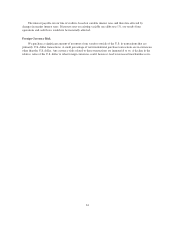Cabela's 2005 Annual Report Download - page 67
Download and view the complete annual report
Please find page 67 of the 2005 Cabela's annual report below. You can navigate through the pages in the report by either clicking on the pages listed below, or by using the keyword search tool below to find specific information within the annual report.
Other Commercial Commitments
2006 2007 2008 2009 2010
There-
after Total
(Dollars in thousands)
Revolving line of credit (1) .......... $ — —————$—
Revolving line of credit for boat
inventory (2) ................... 1,443 ————— 1,443
Bank—federal funds lines (3) ........ — ————— —
Letters of credit ................... 36,708 —————36,708
Standby letters of credit ............ 6,434 ————— 6,434
Total ....................... $44,585 —————$44,585
(1) Our credit agreement allows for maximum borrowings of $325 million including lender letters of credit and
standby letters of credit. As of fiscal year end 2005, the total amount available for borrowing under this
revolving line of credit, including lender letters of credit and standby letters of credit, was $281.9 million.
(2) The revolving line of credit for boat financing is limited to $25.0 million of secured collateral.
(3) The maximum amount of funds on the bank federal funds lines which can be outstanding is $65.0 million of
which no amounts were outstanding at the end of fiscal 2005.
Off-Balance Sheet Arrangements
Operating leases—We lease various items of office equipment and buildings, all of which are recorded in
our selling, general and administrative expenses. Future obligations are shown in the contractual obligations table
above.
Credit Card Limits—The bank bears off-balance sheet risk in the normal course of its business. One form of
this risk is through the bank’s commitment to extend credit to cardholders up to the maximum amount of their
credit limits. The aggregate of such potential funding requirements totaled $7.5 billion as of December 31, 2005
and $6.0 billion as of January 1, 2005, which amounts were in addition to existing balances cardholders had at
such dates. These funding obligations are not included on our consolidated balance sheet. While the bank has not
experienced, and does not anticipate that it will experience, a significant draw down of unfunded credit lines by
customers, a significant draw down would create a cash need at the bank, which likely could not be met by our
available cash and funding sources. The bank has the right to reduce or cancel these available lines of credit at
any time.
Securitizations—As described above under “—Credit Card Loan Securitizations,” all of the bank’s
securitization transactions have been accounted for as sale transactions and the loans relating to those pools of
assets are not reflected on our consolidated balance sheet.
Bank Dividend Limitations and Minimum Capital Requirements
The ability of the bank to pay dividends to us is limited. Such dividends, which would only be made at the
discretion of our board of directors and the bank’s board of directors, may be limited by a variety of factors, such
as regulatory capital requirements, dividend restriction statutes, broad enforcement powers possessed by
regulatory agencies and requirements imposed by membership in VISA. Under the Nebraska Banking Act,
dividends may only be paid out of “net profits on hand,” which the Nebraska Banking Act defines as the
remainder of all earnings from current operations plus actual recoveries on loans and investments and other
assets, after deducting from the total thereof all current operating expenses, losses and bad debts, accrued
dividends on preferred stock, if any, and federal and state taxes for the present and two immediately preceding
calendar years.
55
























